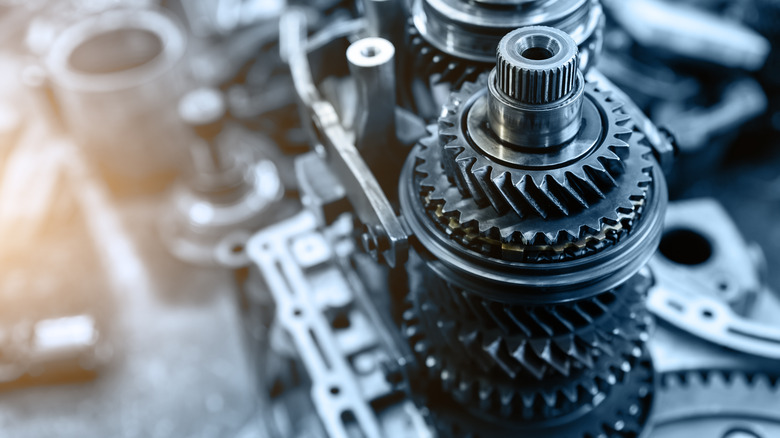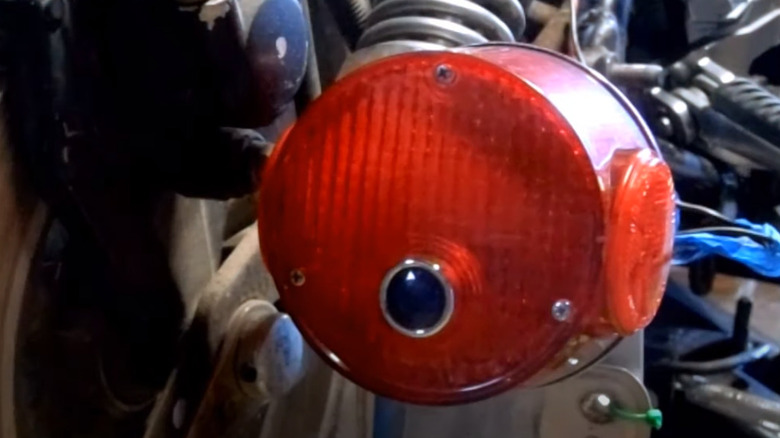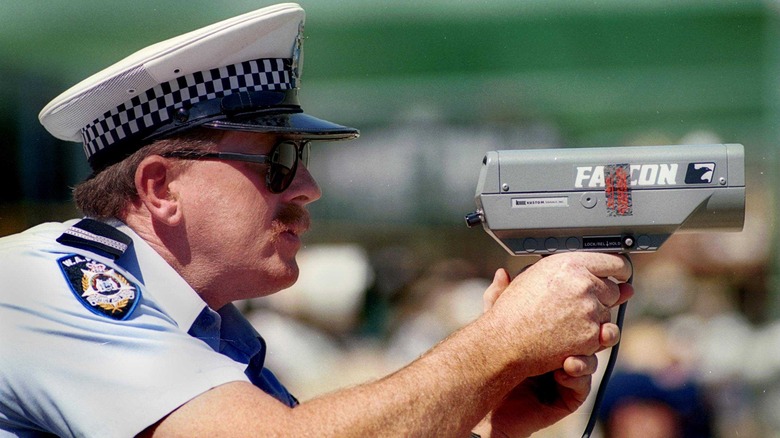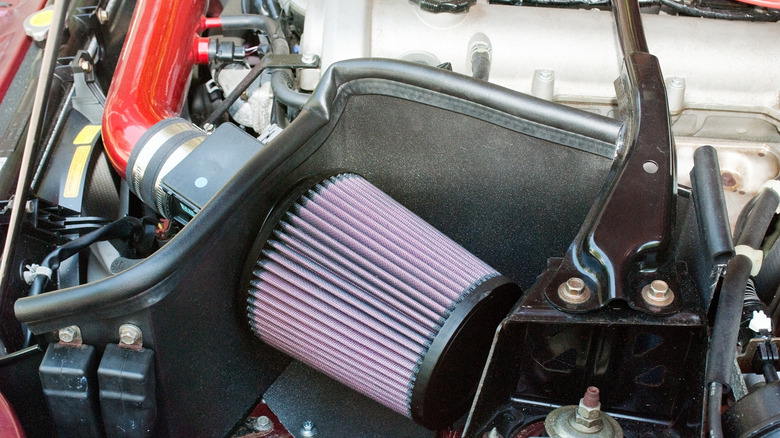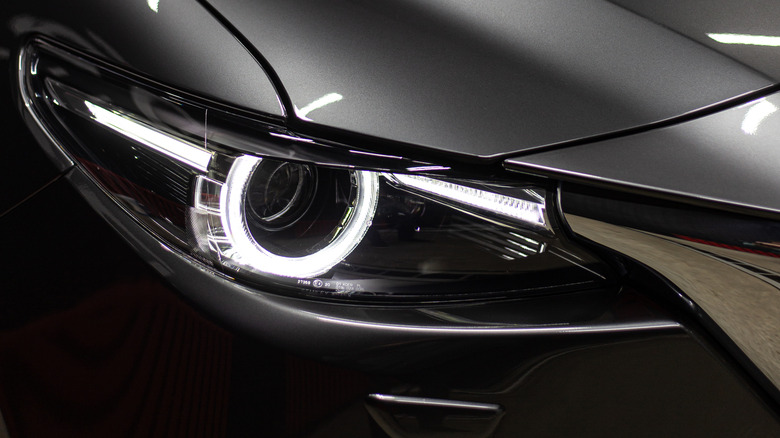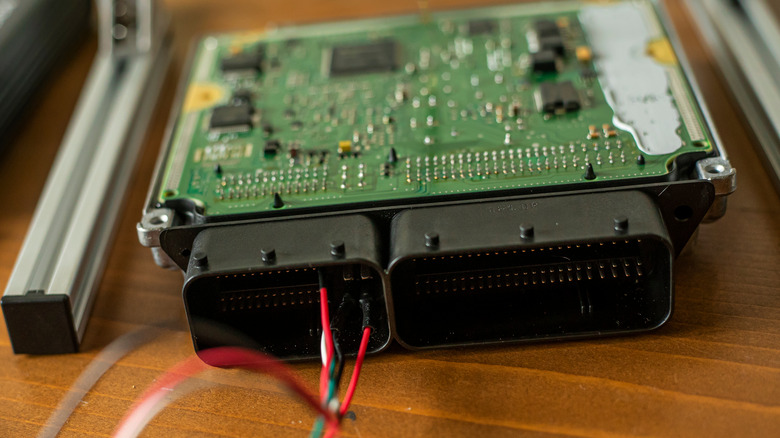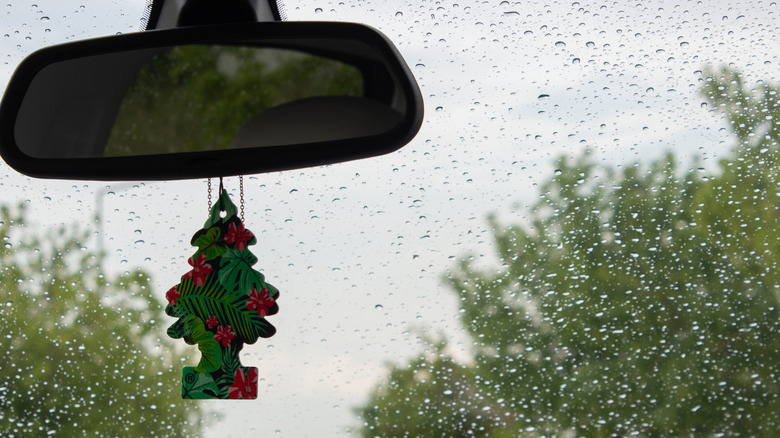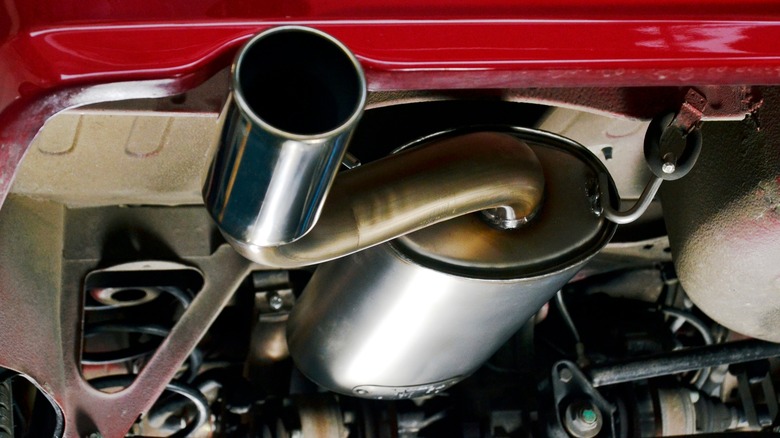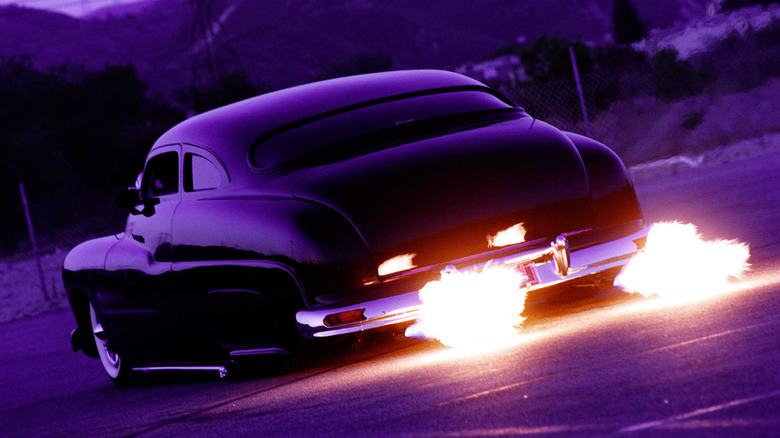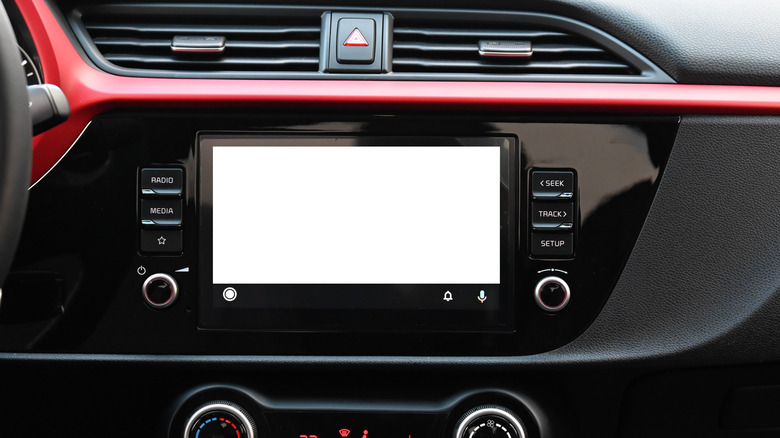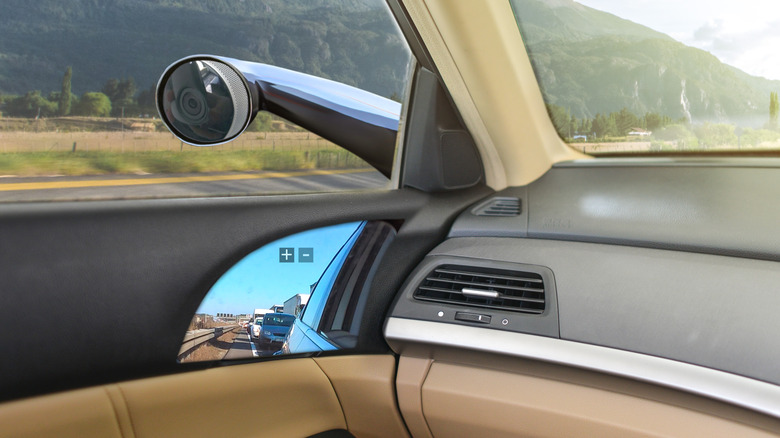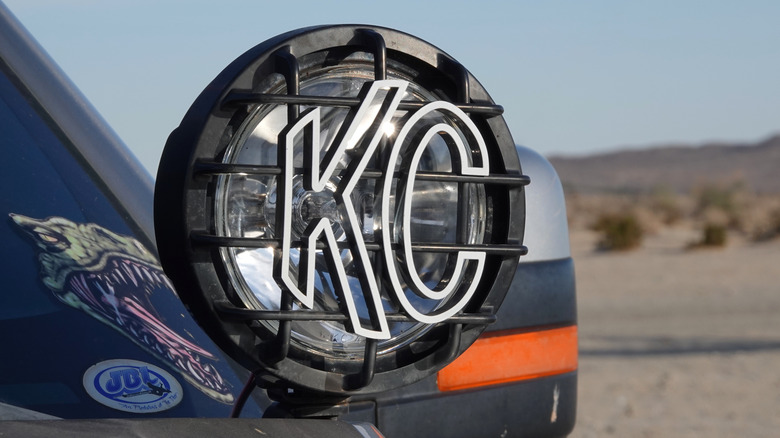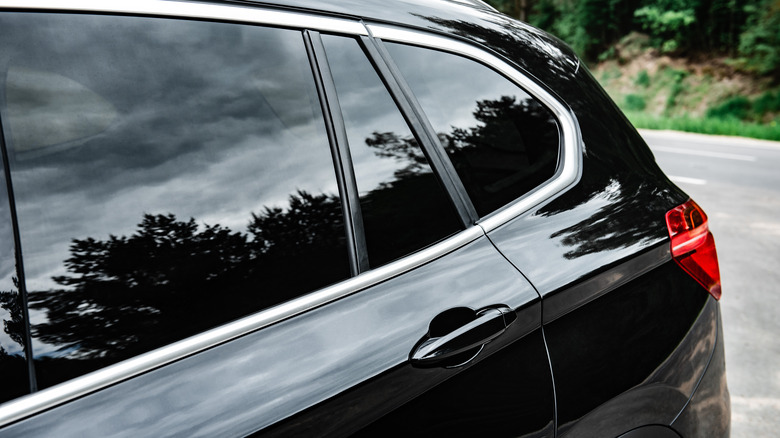The Real Reason This Car Tech Is Banned
Automobiles are wonders of technology, particularly late-model cars. Many of the systems that are part of the modern car have been added as a result of regulations. Most of the regulations surrounding the automobile stem from the desire to make them safer and less polluting. But while most of this tech comes from the factory, some is installed later.
Popular accessories installed by the DIY mechanic may not always be legal. State and federal regulations vary wildly, so it is up to the operator to ensure their vehicle abides by local rules. Still, whether tech is regulated for obscure reasons or an archaic policy that needs to be updated, one thing that is consistent — as long as we have automobiles, there will be a variety of rules to keep them safe on the road. This list includes some of the banned tech and notes why we can't have it on our cars.
Blue dots
No longer common among car mods today, blue dots are a bit of an old-fashioned accessory. These small circles of blue glass can be installed in the center of the lens of a round taillight. They have an unexpected effect when the brake light comes on by making all the light appear bright purple. With only the taillights, they just appear to be blue dots in the middle of red light, but the intensity of the brake lights makes the effect dramatic.
Blue dots will not work on modern cars and are now mostly seen on hot rods based on cars of the '30s, with some post-war cars getting the treatment as well (via MGA Guru). Modern, large taillight assemblies will not work as the lenses are too big for the dots to have any effect. However, it is the effect that makes them illegal. Altering the color of the lens in any way violates traffic codes and the color of lights from the manufacturer is strictly regulated. Federal law prohibits differing colors of taillight and most states have some rule similar to the Texas code 547.322, which states, "A taillamp shall emit a red light plainly visible at a distance of 1,000 feet from the rear of the vehicle." That said, hot rods are often overlooked by law enforcement for these small infractions, so it is not a big concern.
Radar jammers
Going on a road trip is an American tradition, even in the digital era. There are scores of things you might want to see on the way to your destination, including mountains, green fields, and giant novelty food items. Nobody wants to see highway patrol as you roll up over the crest of a hill as you realize you've been kickin' it at 90 for an hour without paying any attention. It's the moment you know you've been caught when the feeling of dread sets in. Some people try to alleviate these issues with radar detectors. They help, but they are not foolproof. Much better to avoid being clocked is a radar jammer (laser jammers are a different story and might be legal where you live). Sophisticated models can be installed into the car with the jamming equipment behind the bumper and wired into the electrical system.
Installing a radar jammer is not, however, a good idea. The FCC forbids any kind of jamming device without express permission for specific activities, and fooling Johnny Law on the interstate is not on that list. The FCC states on its website, "The use of a phone jammer, GPS blocker, or other signal jamming device designed to intentionally block, jam, or interfere with authorized radio communications is a violation of federal law." Additionally, the FCC says the use or marketing of a jammer may result in stiff penalties and imprisonment.
Cold air intake
The cold air intake is among the most common modifications done to modern cars as it is one of the easiest for a novice mechanic. The benefit of the intake is that it, theoretically, draws in cooler air than the standard air intake. Cooler air is denser and contains more oxygen, which is what your engine uses to burn and make power. Finding ways to get cooler air into the engine is a proven method to find a power gain, even if it may be nominal. This can also add flash under the hood and give street cred to racers out on the strip on Saturday nights.
Modifying any part of a modern car runs the risk of altering how it burns fuel, and this can alter the emissions resulting from that burning of fuel. For this reason, cold air intakes may not be legal in all places. The California Air Resources Board, or CARB, has long been tasked with cleaning up the air in California, which was notoriously filthy in the seventies when it was created. Since then, tighter restrictions than federal ones have been adopted for the state and they are rigorously enforced. If you want to get a new intake in any of those states, it will need to be CARB-approved, according to It Still Runs. 12 other states have adopted the same rules and enforced them in the same manner.
Adjustable headlights
For decades, headlights have been tightly controlled by the federal government, forcing carmakers to work within regulations to come up with new designs. Headlight tech has gone through dozens of changes over the decades, but the law often lagged behind. Some of the milestones include 1912 when Cadillac offered the first electrical system to support electric lights in place of acetylene gas lamps. The '50s brought changes to regulations to allow automakers to produce cars with more than two individual headlamps, but they remained round until the '70s. For all of that time, headlights have been required to be static and unable to move while driving (via U. Michigan). That is changing.
The Tucker Torpedo featured a single headlight that turned to illuminate the road around corners, a novel idea. That car never made it to production so its movable light never caught on. The Citroen DS is known for introducing many novel ideas in the way a car functions, and its headlights do turn with the car to illuminate corners but had to be altered with fixed lights for the American market. The infrastructure improvement law passed in 2021 changes regulations to allow for adaptive headlights, which can change the angle at which they illuminate the road based on conditions. Motor Trend reported that the bill gives regulators up to two years to amend the rules and will no longer keep cars such as the Audi A8 from having its Adaptive Matrix Headlights, something offered since 2014.
Tuning equipment
Parts and equipment that alter the tune of an engine really describe a very broad category of accessories and OEM hardware. Anything that changes the tuning of the engine, which means it alters the amount of fuel delivered, the fuel timing, and the ignition timing, can run afoul of federal and state regulations, especially in California and other CARB-compliant states. However, look through catalogs for high-performance parts and accessories you will find lists of modifications, including electronic control units, or ECU, and devices to change the car's factory ECU software.
It is important when purchasing such parts to verify that they are meant for use on the street and that they are compliant with federal laws or CARB regulations in certain states. If you create devices meant to defeat emissions controls, serious penalties can result. The regulations exist to prevent additional pollution in the environment and defeating controls with software undermines all the work manufacturers have done to get it just right. This is a problem for some diesel truck enthusiasts and The Drive reported on one such character who got himself a prison sentence for selling emissions defeat devices for diesel trucks. It is important to remember that the law does not care how you may feel about certain regulations and it is best not to try to subvert it.
Air fresheners
Is an air freshener tech? Maybe, but most people will probably be surprised to find out that air fresheners may be illegal. This applies specifically to the hanging type, such as Little Trees. Buying a Little Tree in the right scent for your first car is a right of passage for many new car owners. Sometimes the smell can be a bit overpowering and some people can't stand them at all. Others won't buy them because they can be used as a pretext for a traffic stop. After all, they may be illegal in some jurisdictions.
The topic of air fresheners took center stage when the New York Times reported on the issue in 2021 based on its relevance to high-profile police interactions. A majority of states have laws prohibiting any object near the windshield that may block the driver's view. This seems pretty straightforward until you realize that this does include seemingly innocuous air fresheners. While they may not block much of the view, the law is usually unambiguous about anything that may block the view, no matter how trivial it may appear. The article goes on to quote certain activists who claim that these laws are used as a pretext to pull people over who are otherwise law-abiding and harmless. The details and assertions regarding the enforcement of these laws will continue to be debated, but, until they are repealed, air freshener bans will continue to be in place.
Exhaust modifications
There was a time when car owners could change and modify their car's powertrain in pretty much any way they wanted. An entire industry exists to meet the needs of weekend racers and hot rodders as well as teenagers with more money than sense. Replacing the exhaust is one of the more popular and cost-effective mods, with everything from mufflers, to larger exhaust pipes, and headers for the engine block. Since the passage of the Clean Air Act and the establishment of the Environmental Protection Agency, these activities have been severely curtailed.
In modern cars, most of the exhaust modifications that can be done have to remain behind any catalytic converters on the car. According to the EPA, it is highly illegal to mess with the catalytic converter of a street-legal vehicle. Altering these parts can contribute to the emission of carbon monoxide and other polluting gases. Some companies do make EPA-approved full exhaust systems, but they are usually expensive and only made for the most popular cars. Otherwise, most people will have to settle for a muffler swap or none at all.
In addition to the federal requirements for emissions, most states have restrictions on how much noise a car can emit. The Specialty Equipment Manufacturers Association has a list of state laws on vehicle noise and what is legal. In many of them, any noise level greater than it had from the factory is prohibited.
Exhaust flame kits
Related to the exhaust mods are the kits made to enable a car to shoot flames out of the tailpipes. If this sounds like a bad idea, lawmakers agree and it is also very illegal. That does not stop boy racers and even some supercar owners from hooking up their cars to become mini flamethrowers. Cars are best modified by people with full use of all available neurons.
California's legal code is quite clear as it reads, "No motor vehicle shall be operated in a manner resulting in the escape of excessive smoke, flame, gas, oil, or fuel residue." It should be assumed other states have similar language in the books. That said, it hasn't prevented some enterprising companies from offering these kinds of kits, which you can buy online for around $150. Those who partake just have to be willing to accept the risk of getting busted.
In-dash view screens
This may sound a bit counterintuitive with the proliferation of screens in the current slate of cars for sale. Screens are overtaking dashboards and replacing all manner of physical buttons and controllers. But these are perfectly legal as they help the car function. What is not legal is a screen that is capable of playing video while the car is in motion. Tesla offers video playback on its screens, but only while parked. Many aftermarket in-dash stereos offer screens but are meant to be wired in such that the parking brake must be applied before it will operate with video playback.
It should be obvious that video playing within sight of the driver is a bad idea, but people install these things all the time. Best Car Audio explains the legality of it and the best practices and advises against installing overrides. This is especially prevalent among custom rides with an emphasis on the stereo and interior accessories over the performance of the car. Plenty of shops will bypass the safety features and install the screens to work all the time. These installations likely will never be penalized unless an eagle-eyed office catches them playing while in traffic. Still, it is best to leave it off.
Side view mirror cameras
One of the more recent exciting developments in the world of auto design is side view mirror cameras. This new technology allows automakers to replace the side-view mirror with a camera that displays on small screens just inside the doors. This is especially good for ultra-high-performance cars that rely on the least possible amount of drag and eliminating anything that can cause drag is imperative. However, they are not legal on US roads.
This is an example of technology advancing faster than legislation, which is a common issue. Regulations for safety equipment such as lights and mirrors are explicitly detailed in the US auto code and cars are not allowed to deviate from those rules at all. Sometimes rules remain long after they are useful, or, in this case, new technology supersedes the current technology, but does not yet have clearance. We reported that this may soon change as the National Highway Traffic Safety Administration is considering changes to rules to accommodate these cameras.
Off-road lights and light bars
Rules stipulating how manufacturers include lighting on cars can sometimes apply to aftermarket products, such as off-road lighting. As the name suggests, many kits are available to add to a vehicle, usually, a truck, to provide lighting for driving on trails or in the woods at night. Some of these kits can be quite elaborate and sophisticated.
KC Lights is a popular manufacturer of lighting accessories for automobiles and lists a fairly comprehensive guide to accessory lighting rules. The guide says that mostly the laws among the states vary widely and it is important to check them for whatever locale you are operating in. But the general tip is not to drive with any of the added lights while on public roads unless they have been built to specific DOT regulations. Otherwise, some states have a limit on how many can be installed and others require individual lights to have a physical cover while on public roads. It is a bad decision to run down the interstate with your lightbar on as it will blind drivers in oncoming traffic. These regulations are designed specifically to avoid driving accidents at night.
Window tints are easy to spot and regularly banned
While tinted windows may be both desirable, and in some cases practical, they are banned in almost every U.S. state. They're also pretty easy to spot, and even if your level of tint is just within the legal limit it may still give a law enforcement officer a good reason to pull you over. Penalties also vary from jurisdiction to jurisdiction, but you can usually expect a fine of some kind. Window tint is measured based on the amount of light the glass will let through. So a 25% tint will let a quarter of the light hitting it through, an 80% tint will only block 20% of the light, and so on.
Windshield tinting, aside from a strip at the top, is the most widely banned type of tint for obvious reasons. While the tint can stop bright sunlight or another vehicle's high beams from blinding you, it can also severely impair your vision. This gets worse in low-light conditions, so you should really avoid opting for a tinted windshield wherever you are. As far as other windows go, it varies greatly from state to state. Arkansas allows 25% tinting on side windows and 10% on rear windows, whereas New Jersey won't allow drivers to tint their front windows. This is for good reason, as an officer performing a traffic stop won't be able to see what is happening in the car. The logic is, if someone has a firearm and intends to do the officer harm, the window tints will stop the officer from noticing before it's too late.
